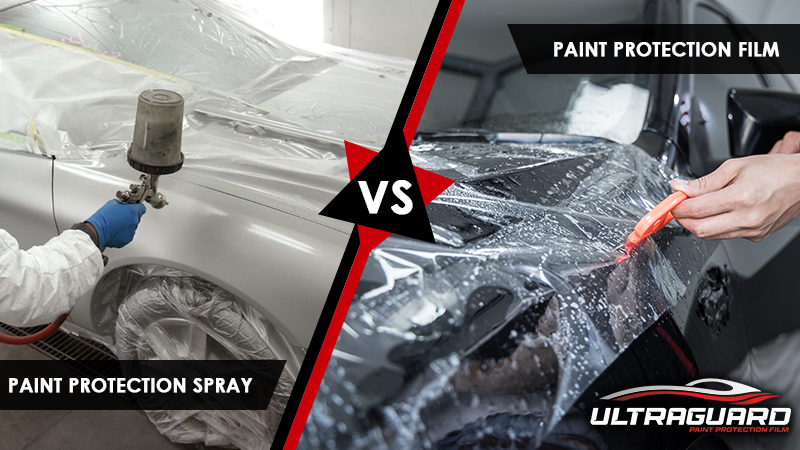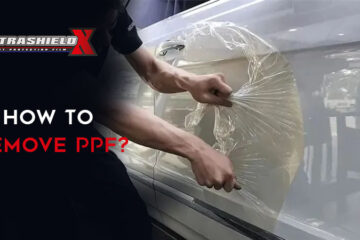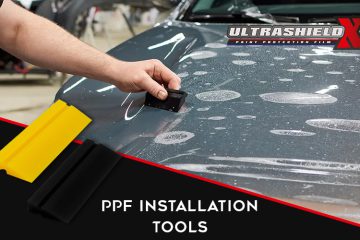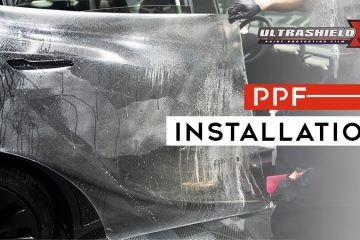Buying a car or bike alone isn’t necessary. You need to preserve its beauty until the time you use your vehicle. Paint Protection Spray and Paint Protection Film are two popular options among auto enthusiasts to preserve the showroom finish of their vehicles.
Both options serve the same purpose of forming an additional layer of paint protection, but they both have different features.

Paint Protection Spray vs Paint Protection Film
In this blog, we will explain to you the major difference between Paint Protection Spray vs Paint Protection Film. Also, at the end of this blog, we will give you an answer which is best for you.
What is a Paint Protection Film?
Paint protection film is a protective film to protect the vehicle’s exterior paint. Just like you protect your mobile’s screen with tempered glass, With the paint protection film installed on the vehicle, your vehicle’s surface will remain flawless and unhampered by minor scratches, abrasion, and discoloration.
Paint protection film is measured, cut, and installed by an expert. PPF films are highly durable by nature. They will last and protect your vehicle for 5 to 10 years. Some high-quality films even work for 15 years if maintained properly. Also, all the minor scratches and swirl marks get self-healed if you expose the film to little heat using a heat gun.
They work excellently to safeguard the vehicle’s surface from UV rays, minor scratches, oxidation, water spots, and other paint surface damaging agents like rock chips, gravels, acid rain, tree saps, and others.
Features of Paint Protection Film or PPF
Below are some PPF features you need to understand before we compare Paint Protection Spray vs PPF.
1.) Self-healing property:
When your vehicle is PPF-protected, you do not have to worry about minor scratches and abrasions as they will be self-healed. All minor imperfections will be absorbed by the film.
2.) Defense against UV rays:
UV rays are the major culprit for paint discoloration. When your vehicle is exposed to UV rays for a long period, the paint will fade with time. PPF can absorb the impact of UV rays and safeguard your vehicle.
3.) Resists Stains:
Road grime, bird droppings, acid rain, tree saps, bug guts, air pollution, and other natural chemical contaminants will damage the exterior surface shine. PPF will form a robust shield over the surface which will keep the original paintwork unhampered.
4.) Durability:
Paint protection films can last for up to 15 years if maintained with the car. A vehicle has a lifespan of 15 years and so does good-quality PPF. Some high-grade PPF will last for a vehicle’s lifetime.
5.) Hydrophobic properties:
Hydrophobic property is also known as the ability to repel water. PPF has an excellent hydrophobic property, which will prevent water stains and will make vehicle cleaning and maintenance easier.
What is Paint Protection Spray?
The Auto Detailing industry time to time is evolving with new technologies. Spray on PPF or paint protection spray (PPS) is a revolution if we talk about paint protection alternatives.
Just like a car is repainted, PPS is applied to the vehicle. It is applied by professionals in the paint booth using a spray gun. When you paint a car, the paint is permanent. But paint protection spray can be removed if it gets damaged or scratched by any environmental factors like tree branches, road debris, swirl marks, and more.
A sprayable film is composed of three layers, the primer, the basecoat, and the gloss top coat. It has a thickness of up to 350 microns.
Features of Paint Protection Spray (PPS) or Spray on PPF
Read some of the PPS features you need to understand before understanding the PPS vs Paint Protection Film difference:
1.) Adhesive Free:
Paint Protection Spray is directly sprayed onto the vehicle’s surface, which will leave no room for adhesive or glue on the surface.
2.) Form a thick layer of protection:
PPS or Paint Protection Spray, comes with a thickness of 350 microns, which will make it less prone to paint damage.
3.) Durability:
Once applied and cured, spray-on PPF forms a strong and durable barrier against various environmental hazards such as road debris, bird droppings, tree sap, and UV radiation, for up to 5 years.
4.) UV protection:
PPS will absorb all the UV rays emitted from the sun, which will prevent discoloration of the vehicle’s paint.
5.) Easy to remove:
Paint protection spray is easy to remove and will leave stains on the surface.
Paint Protection Spray vs PPF – Difference
Both Paint Protection Spray and Paint Protection Film are designed to protect the vehicle’s paintwork but have different application methods, levels of protection, and durability. Below are some main differences between Paint Protection Spray vs Paint Protection Film:
1.) Application Method:
- Paint Protection Spray: They are directly applied to the vehicle’s surface using a spray gun. They need to be installed in a specially designed spray booth.
- PPF: They are physical films installed by a professional installer. The film is carefully applied to the surface and then trimmed according to the size of the panel and installed.
2.) Protection level:
- Paint Protection Spray: They have a thickness of up to 300 microns which forms a thick layer over the painted surface and gives more protection than paint protection films.
- PPF: They have a thickness of up to 220 microns.
3.) Longevity:
- Paint Protection Spray: Paint protection sprays typically last for up to 5 years maximum, depending on factors such as environmental conditions and maintenance.
- PPF: Paint Protection Film is more durable and long-lasting compared to paint protection sprays. When properly installed and maintained, PPF can last for up to 15 years.
4.) Cost:
- Paint Protection Spray: PPS is generally more costly than PPF as it is comparatively new to the market. There are very few detailers in India who provide this service.
- PPF: Paint Protection Film is more affordable than PPS due to multiple brands offering this service.
5.) Self-healing Property:
- Paint Protection Spray: They are not self-healing. If PPS gets minor imperfections you have to replace the whole to get a flawless finish.
- PPF: Paint protection films are self-healing in nature. Minor swirl marks and scratches will vanish in contact with minor heat.
Here are some of the major differences between PPS vs PPF.
PPF vs PPS – Brief Comparison
| Features | Paint Protection Spray | Paint Protection Film |
| Scratch-resistance | Do not prevent scratches | Prevents scratches |
| Layer of protection | Forms a thick layer of protection for up to 350 microns | Forms a protective layer of protection for up to 22o microns |
| Durability | Lasts for up to 5 years | Lasts for 5 to 15 years |
| Time of installation | Takes at least 1 week to cure | Takes 3 days to finish the work |
| Self-healing | PPS is not self-healing | PPF is self-healing |
| Varieties Available | PPS comes in limited varieties i.e., Matte and Gloss | Comes in multiple colors |
| Cost | Expensive than PPF | Affordable than PPS |
What’s Best for you?
Based on our experience, paint protection spray might seem better than paint protection film at first, but that’s just theory. Spraying it on means no visible seams or cuts on big car parts. But in reality, putting it on without any flaws requires taking apart a lot of panels, which can be a hassle.
In our observation, paint protection spray doesn’t last as long as paint protection film. It loses its shine pretty quickly and doesn’t fix scratches as well as the film does. Plus, applying it might mean taking your car apart quite a bit.





0 Comments